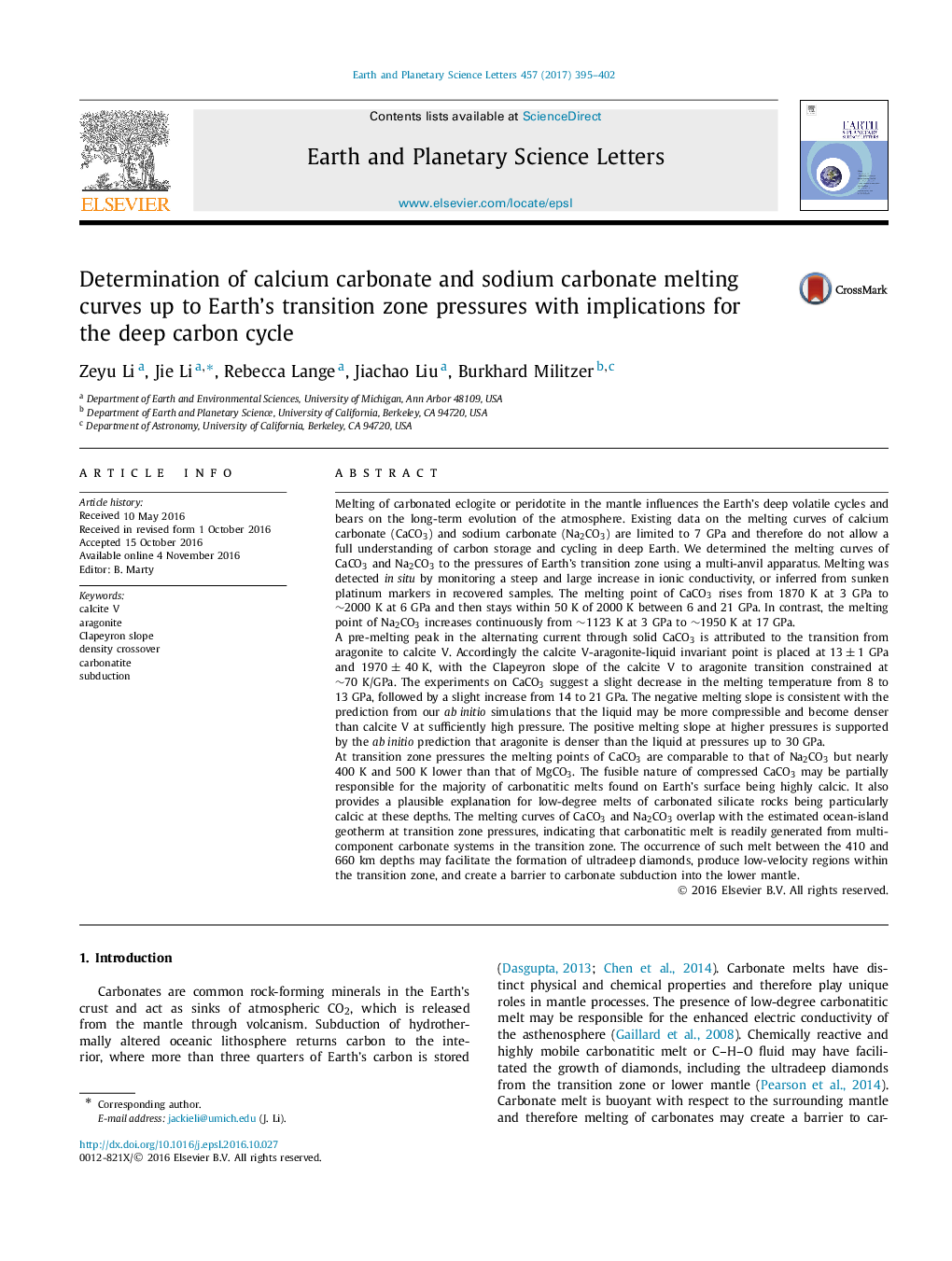| کد مقاله | کد نشریه | سال انتشار | مقاله انگلیسی | نسخه تمام متن |
|---|---|---|---|---|
| 5780078 | 1634699 | 2017 | 8 صفحه PDF | دانلود رایگان |
- Experiments show that between 6 and 21 GPa CaCO3 melts within 50 K of 2000 K.
- Experiments place the calcite V-aragonite-liquid invariant point at 13 GPa and 1970 K.
- Experiments show that Na2CO3 melting point rises with pressure to 1950 K at 17 GPa.
- Experiments and simulations suggest a density crossover between calcite V and liquid.
- Simulations confirm that aragonite is denser than liquid at pressures up to 30 GPa.
Melting of carbonated eclogite or peridotite in the mantle influences the Earth's deep volatile cycles and bears on the long-term evolution of the atmosphere. Existing data on the melting curves of calcium carbonate (CaCO3) and sodium carbonate (Na2CO3) are limited to 7 GPa and therefore do not allow a full understanding of carbon storage and cycling in deep Earth. We determined the melting curves of CaCO3 and Na2CO3 to the pressures of Earth's transition zone using a multi-anvil apparatus. Melting was detected in situ by monitoring a steep and large increase in ionic conductivity, or inferred from sunken platinum markers in recovered samples. The melting point of CaCO3 rises from 1870 K at 3 GPa to â¼2000 K at 6 GPa and then stays within 50 K of 2000 K between 6 and 21 GPa. In contrast, the melting point of Na2CO3 increases continuously from â¼1123 K at 3 GPa to â¼1950 K at 17 GPa.A pre-melting peak in the alternating current through solid CaCO3 is attributed to the transition from aragonite to calcite V. Accordingly the calcite V-aragonite-liquid invariant point is placed at 13±1 GPa and 1970±40 K, with the Clapeyron slope of the calcite V to aragonite transition constrained at â¼70 K/GPa. The experiments on CaCO3 suggest a slight decrease in the melting temperature from 8 to 13 GPa, followed by a slight increase from 14 to 21 GPa. The negative melting slope is consistent with the prediction from our ab initio simulations that the liquid may be more compressible and become denser than calcite V at sufficiently high pressure. The positive melting slope at higher pressures is supported by the ab initio prediction that aragonite is denser than the liquid at pressures up to 30 GPa.At transition zone pressures the melting points of CaCO3 are comparable to that of Na2CO3 but nearly 400 K and 500 K lower than that of MgCO3. The fusible nature of compressed CaCO3 may be partially responsible for the majority of carbonatitic melts found on Earth's surface being highly calcic. It also provides a plausible explanation for low-degree melts of carbonated silicate rocks being particularly calcic at these depths. The melting curves of CaCO3 and Na2CO3 overlap with the estimated ocean-island geotherm at transition zone pressures, indicating that carbonatitic melt is readily generated from multi-component carbonate systems in the transition zone. The occurrence of such melt between the 410 and 660 km depths may facilitate the formation of ultradeep diamonds, produce low-velocity regions within the transition zone, and create a barrier to carbonate subduction into the lower mantle.
Journal: Earth and Planetary Science Letters - Volume 457, 1 January 2017, Pages 395-402
